FLIES
Use sub tabs for more details.
As with much on this website, be aware that it has not been compiled from an expert's view of insects, but rather to encourage inquistiveness and enthusiasm about the minute world around us.
Also see INSECTS below. index.asp?pageid=731468
There are so many. The smaller ones are all the more difficult to identify.
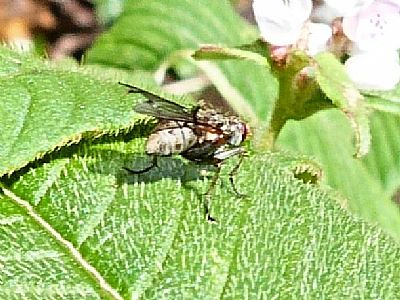
This much smaller than average fly with a whitish abdomen has not been identified.
We are certainly not short of flies. House flies, Horse flies, Bluebottle flies and Common greenbottle. But then there are also hoverflies, mayflies, craneflies and many many others. In fact there are over 7,000 species of fly in the UK. Identifying exactly which one has settled on that flower or is buzzing around your kitchen or hovering around the dirt can be daunting.
To aid us the Natural History Museum offers good advice on its website and this links to a flyfinder that can be downloaded as an app on your phone. On the subtabs you can find a few. Their identification here is based on what is at hand and not any scientific basis. If you need firmer confirmation, contact an expert and p erhaps participate in the Natural History Museum project.
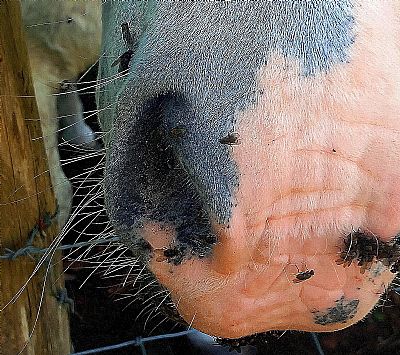
A hot summer day and a variety of flies both a horse. They seek out the slightly damp areas such as the nose and eyes and as you can imagine, even more personal areas. Fortunately the owners have given this horse a protective gauze over the eyes and ears, but this is not possible over the mouth and nostrils. Horse flies in particular are very problemmatic. In summer, female horse flies bite people and animals to feed on their blood. The flies may lay eggs on nearby rocks and plants or on the animals themselves.
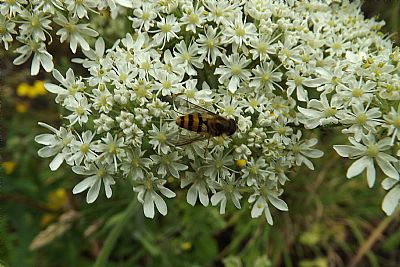
Can't see the fly for the flower? Look closer and you may find a great variety of little creatures. But is it a fly or a bee? This one is a hoverfly.
LIFE CYCLE OF FLIES
The life cycle of flies is short ie around 15-30 days and as with all insects, the go through four stages. [That in italics is from Fantastic Pest Control - link below].
Stage 1 = Eggs
After mating, the female flies lay eggs and the males fertilise them. Flies lay their eggs in warm, moist spaces, usually on decaying organic matter such as food waste, garbage, carrion, animal or human faeces.
After reaching maturity, usually around the 12th day, the female fly can lay over 500 eggs in her entire lifetime, in batches of between 75 and 150.
Flies usually lay their eggs on moist, decaying organic matter, such as food waste, carrion or faeces. They are white and elongated, normally around 0.05 inches long. Fly eggs take between 8 and 20 hours to hatch.
Stage 2 = larvae / maggots
Fly larvae are worm-like in shape and pale in colour. They stay close to their source of food and feed best when on animal corpses, manure and garbage. Maggots eat in order to grow and begin their moulting process. This is essentially the process of insects shedding their skin or their exoskeleton. This happens when a new skeleton beneath has been fully developed. The moulting period in flies happens three times before the fly enters its next life cycle stage.
Stage 3 = pupae
After the final moulting, the larva enters the pupa stage. During this stage, flies are usually dormant - do not move and do not feed. They develop a cocoon-like shell and grow their wings, antennas and legs.
Stage 4 = Adult flies.
Once they break out of their shell, flies are fully grown and now in their adult form.
THE EFFECT OF FLY EGGS ON PETS
Fly eggs may be inadvertently ingested by us if they have been laid on food that has been exposed for a while. This is generally not a problem for humans.
If dogs ingest them, they too generally have little effect. Fly eggs can have detrimental bacteria, but dogs are usually able to cope with that. Even if the eggs turn into maggots, they can generally cope. If you are unsure and your dog has shown symptoms of reaction then take it to the vet. If you are unsure if the food has been contaminated, then cooking it first will remove any dangers.
Cats too can ingest fly worms with little or no effect. Their digestive system simply breaks them down. But cats are more selective eaters and will usually realise something is wrong with their food and refuse it.
Of course if there is always recourse to deworming medication.
Wild animals are probably dealing with this naturally all the time.
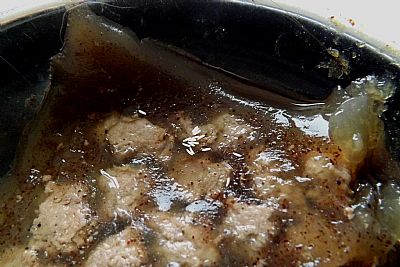
Fly eggs laid on cat food within a short time of being put in the bowl. These are most likely from a single house fly that got into the kitchen. The cat realised this and refused the food.
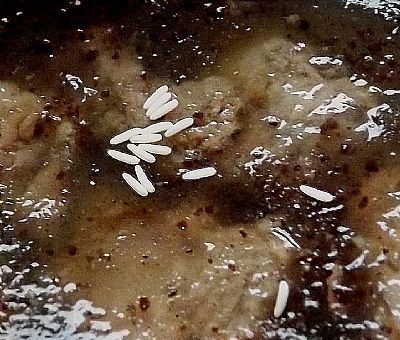
A close-up of the same fly eggs. They look like tiny grains of rice. These were wuickly disposed of, but if left can turn into maggots.
ASK PET GURU website : https://askpetguru.com/is-it-safe-for-dogs-to-eat-fly-eggs/
FANTASTIC PEST CONTROL website : https://www.fantasticpestcontrol.co.uk/flies/fly-life-cycle/#:~:text=Their%20life%20cycle%20includes%20four%20stages%20-%20egg%2C,can%20lay%20over%20500%20eggs%20in%20her%20lifetime.
GEDLING CONSERVATION TRUST - This is based on reclaimed lagoons in England, but is an extraordinary record in great detail of such wildlife as flies and a very useful reference : https://www.gedlingconservationtrust.org/species-index/flies/
INSECTS OF BRITAIN AND WESTERN EUROPE. Chinery, Mark. A Collins Guide. ISBN 000 219137 7. 1986. This is an extraorinarilly comprehensive catalogue of almost every insect, bug and butterfly that we can possibly encounter.
NATURAL HISTORY MUSEUM : https://www.nhm.ac.uk/take-part/citizen-science/fly-finder.html Also see their pdf flyfinder guide which gives some basic ionformation. https://www.nhm.ac.uk/content/dam/nhmwww/take-part/Citizenscience/fly-finder/fly-finder-id-sheet.pdf
PEST DEFENCE : https://www.pestdefence.co.uk/news/types-of-flies-in-the-uk/
PEST KEEN website : https://www.pestkeen.com/fly-eggs-on-food/

